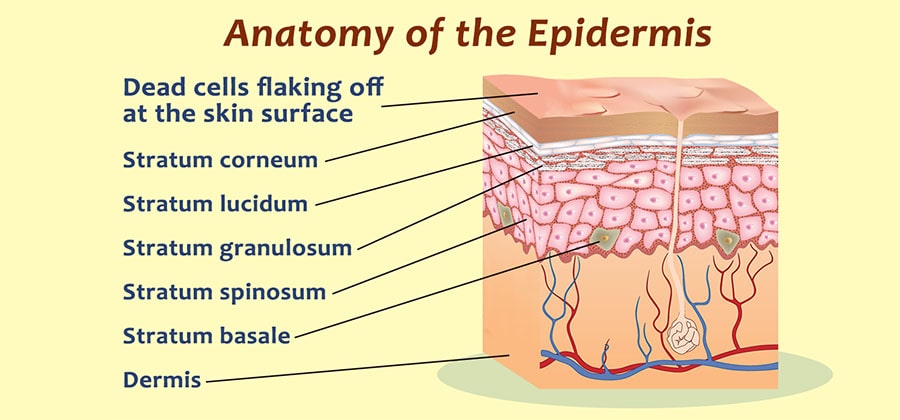Familiarity with skin layers
In order to know the skin and to know what causes its damage, the best way is to know the layers of the skin and to know the function of each of these layers of the skin.
In the continuation of this article, we will learn a little about the anatomy of the skin, its function and the cases of damage to the layers of the skin.
Skin
Skin layers
اپی درم
درم
Hypodermis
Skin anatomy
Skin thickness
Familiarity with skin appendages
As you can see in the picture, the skin is composed of several layers, each of which contains its own sub-layers with its own function.
Introduction to skin:
It is the covering and protective part of the body, which in addition to having a very significant effect on our appearance, also shows our internal health. It can be said that in most cases, the skin is a mirror for our internal interactions, for example, hirsutism, which is caused by hormonal problems, manifests itself as hair, or women's problems, such as ovarian cysts, cause more acne on the surface of the skin. It is a sign of hormonal problems caused by these diseases. The layers of the skin make up about 7-8% of the body weight and its surface should naturally be smooth and soft and not too dry or too oily when touched.
Familiarity with skin layers:
The skin is made up of three main layers, each of which contains sub-layers and appendages that have their own function and play a role in maintaining the overall structure of the skin. These layers of skin are arranged in order from surface to depth:
اپی درم
درم
Hypodermis
In the case of the epidermis, it is composed mostly of dead cells, and the hypodermis plays a major role in warming the body.
Introduction to the epidermis layer:
The outermost layer of the skin is made up of several cellular layers. The first step in understanding the anatomy of the skin is to look deep into the surface of the epidermal layers. We can introduce the deepest layer as the basal layer and the most shallow as the horny layer. After depth to the surface in the epidermis layer:
Basal layer or base layer
Squamous layer (spinosum stratum - squamous layer)
Granolosum stratum (Granular layer)
Transparent or glossy layer (lusidum layer) This layer is found only on the soles of the feet
Corneal stratum
The epidermal layer of the skin that is blue in the image
To read more: What is Fractional RF?
Familiarity with the basal layer
This layer of skin contains three types of cells.
1. Keratinocytes:
Keratinocyte cells, which make up more than 90% of the cells in this layer of skin. The job of these cells is to produce and store creatine, which prevents water from evaporating from the surface of the skin.
When these cells are made from the deepest layers of the skin, they come to the surface, and as they reach the surface of the skin, they move away from the blood vessels that supply oxygen and nutrients to these cells, resulting in deformation and flattening. As dead cells, they separate from the surface of the skin and shed.
2. Melanocyte cells:
These cells make melanin pigment pigments. These cells have appendages such as the leg (false leg) that help to release and transfer melanin between keratinocyte cells. During the process of melanin synthesis and transfer and release, in addition to creating skin color, it is also effective in protecting the keratinocyte cells of the basal layer of the epidermis and other skin layers.
By absorbing light and ultraviolet rays, melanin prevents damage to other cells in the skin layers and their cancer. However, an increase in these melanocytes, which produce melanin, can cause skin blemishes in cases such as aging or their benign proliferation in the sun.
3. Merkel cells
In short, Merkel cells in anatomy of the skin are located in the basal region of the epidermis and are responsible for the sense of skin touch. Sometimes in performing cosmetic processes such as Haifu and Araf, when we feel the scalp and lack of touch in the skin, it is due to the temporary failure of these cells.
Melanocytes are the cells that are responsible for the color of our skin and are exposed to the sun
We become bronze
Squamous layer (spinosum stratum - squamous layer):
This layer is made up of several rows of cells that become flatter as they get closer to the surface of the skin, and one of the things done in this layer is to hold the keratinocytes in the previous layer together. These joints help the skin to resist friction.
In addition, there are cells in this layer called Langerhans, which perform the act of xenophobia for the skin.
The barbed layer in this image is blue.
Granolosum stratum (Granular layer)
Like the previous layer, it is composed of several cell layers and, like a cement, prevents the penetration of water and foreign agents into the skin.
Transparent or glossy layer (lusidum layer):
This layer of skin is only seen on the thick skin of the soles of the feet and hands, and this layer acts like a previous layer as a kind of cement for the cell.
Corneal stratum:
This layer of cells is made up of broad, dead keratinocytes that lack a nucleus and are firmly attached to each other. The cells inside this layer (cytoplasm) are filled with creatine, which prevents dry skin. Keep in mind that if the layer is repeatedly exposed to physical damage, it will thicken to further protect the skin, for example, those who do a lot of work with their hands, such as athletes or farmers.
The most superficial layer of skin that is in contact with the outside environment and thickens in case of pressure and damage

